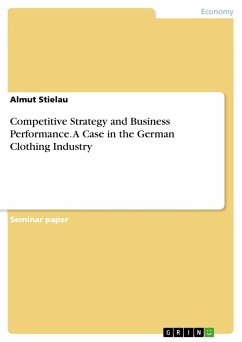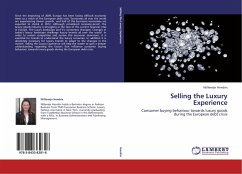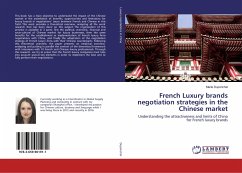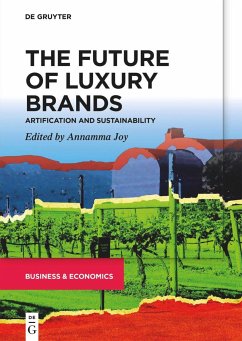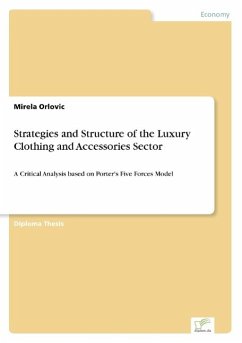
Strategies and Structure of the Luxury Clothing and Accessories Sector
A Critical Analysis based on Porter's Five Forces Model
Versandkostenfrei!
Versandfertig in 1-2 Wochen
68,00 €
inkl. MwSt.

PAYBACK Punkte
0 °P sammeln!
Diploma Thesis from the year 2002 in the subject Business economics - Trade and Distribution, grade: 1,0, University of Dusseldorf "Heinrich Heine" (Wirtschaftswissenschaftliche Fakultät), course: Lehrstuhl für BWL, insbes. Produktionswirtschaft und Umweltökonomie, language: English, abstract: Inhaltsangabe:Introduction:The luxury goods industry is a fascinating field. As Jean-Louis Dumas-Hermès, chairman and CEO of Hermès, explains: Le luxe, c est créer un rêve qui perdure. In addition to the dream dimension that defies scientific analysis, the luxury goods companies have kept highly s...
Diploma Thesis from the year 2002 in the subject Business economics - Trade and Distribution, grade: 1,0, University of Dusseldorf "Heinrich Heine" (Wirtschaftswissenschaftliche Fakultät), course: Lehrstuhl für BWL, insbes. Produktionswirtschaft und Umweltökonomie, language: English, abstract: Inhaltsangabe:Introduction:
The luxury goods industry is a fascinating field. As Jean-Louis Dumas-Hermès, chairman and CEO of Hermès, explains: Le luxe, c est créer un rêve qui perdure. In addition to the dream dimension that defies scientific analysis, the luxury goods companies have kept highly secretive. Alain D. Perrin, President and CEO at Cartier International, elucidates: One of our strengths is our ability to maintain a certain mystery about the economic entity which is the company. We bring magic and dreams to consumers who don t want to see their favourite brands discussed in the media, and lacking any sense of the romantic. Systematic research confines itself mainly to specialised marketing literature, especially that of French scholars.
But recent developments have raised various questions and call for more systematic research in diverse fields. Over the past two decades, luxury companies in particular in the clothing sector have had to face an increasingly turbulent environment. On the supply side, French dominance especially in the haute couture sector has been challenged as competition has increased mainly from Italian and American fashion houses. Furthermore, the traditionally fragmented luxury industry has become more concentrated, a visible sign for the consolidation was the merger of Louis Vuitton and Moët Hennessy in 1987. Finally, as a result of diversification strategies, most fashion houses have extended to more accessible luxury products and as a result, realize now a substantial part of sales in both, clothing and accessories. But also the demand side has been substantially changing. In 1899, the American economist Thorstein Veblen published the first proper study of consumerism, in which he identified and analysed the traditional luxury customer group which he called leisure class.
It was not until the 1980s that the leisure class was joined by newly rich and occasional customers from the middle class. On the one hand, the luxury industry has expanded to more accessible products and to new geographical markets, and on the other hand, a growth in wealth of the Western industrialized nations has increased purchase of luxury goods. These mostly fundamental changes have challenged and will furthermore challenge the fashion houses and the ability to establish a competitive advantage. The objective of this thesis is gaining a thorough understanding of the luxury clothing and accessories sector, by elaborating on these developments and working out characteristics, competitive forces and main issues. The analysis serves then as a basis for strategy formulation that is aimed creating a long-term competitive advantage.
Porter s five forces framework has been chosen for conducting the analysis, be-cause it provides a structured approach for examining a particular sector. Michael E. Porter has developed the model of the five forces in his book Competitive Strategy. Techniques for Analyzing Industries and Competitors in 1980. With combining the fields of business strategy and industrial organization economics, Porter developed the work of Kenneth Andrews, commonly known as the SWOT analysis, but focused on the structure of the industry. He argues that intensity of competitive rivalry, the bargaining power of suppliers and buyers and the threat of substitutes and new entrants define the structure and thus, profitability and attractive-ness of an industry. Based on the five forces analysis, Porter suggests three generic strategies that companies could implement to establish a competitive advantage: The cost leadership strategy focuses on offering customers a compe...
The luxury goods industry is a fascinating field. As Jean-Louis Dumas-Hermès, chairman and CEO of Hermès, explains: Le luxe, c est créer un rêve qui perdure. In addition to the dream dimension that defies scientific analysis, the luxury goods companies have kept highly secretive. Alain D. Perrin, President and CEO at Cartier International, elucidates: One of our strengths is our ability to maintain a certain mystery about the economic entity which is the company. We bring magic and dreams to consumers who don t want to see their favourite brands discussed in the media, and lacking any sense of the romantic. Systematic research confines itself mainly to specialised marketing literature, especially that of French scholars.
But recent developments have raised various questions and call for more systematic research in diverse fields. Over the past two decades, luxury companies in particular in the clothing sector have had to face an increasingly turbulent environment. On the supply side, French dominance especially in the haute couture sector has been challenged as competition has increased mainly from Italian and American fashion houses. Furthermore, the traditionally fragmented luxury industry has become more concentrated, a visible sign for the consolidation was the merger of Louis Vuitton and Moët Hennessy in 1987. Finally, as a result of diversification strategies, most fashion houses have extended to more accessible luxury products and as a result, realize now a substantial part of sales in both, clothing and accessories. But also the demand side has been substantially changing. In 1899, the American economist Thorstein Veblen published the first proper study of consumerism, in which he identified and analysed the traditional luxury customer group which he called leisure class.
It was not until the 1980s that the leisure class was joined by newly rich and occasional customers from the middle class. On the one hand, the luxury industry has expanded to more accessible products and to new geographical markets, and on the other hand, a growth in wealth of the Western industrialized nations has increased purchase of luxury goods. These mostly fundamental changes have challenged and will furthermore challenge the fashion houses and the ability to establish a competitive advantage. The objective of this thesis is gaining a thorough understanding of the luxury clothing and accessories sector, by elaborating on these developments and working out characteristics, competitive forces and main issues. The analysis serves then as a basis for strategy formulation that is aimed creating a long-term competitive advantage.
Porter s five forces framework has been chosen for conducting the analysis, be-cause it provides a structured approach for examining a particular sector. Michael E. Porter has developed the model of the five forces in his book Competitive Strategy. Techniques for Analyzing Industries and Competitors in 1980. With combining the fields of business strategy and industrial organization economics, Porter developed the work of Kenneth Andrews, commonly known as the SWOT analysis, but focused on the structure of the industry. He argues that intensity of competitive rivalry, the bargaining power of suppliers and buyers and the threat of substitutes and new entrants define the structure and thus, profitability and attractive-ness of an industry. Based on the five forces analysis, Porter suggests three generic strategies that companies could implement to establish a competitive advantage: The cost leadership strategy focuses on offering customers a compe...






